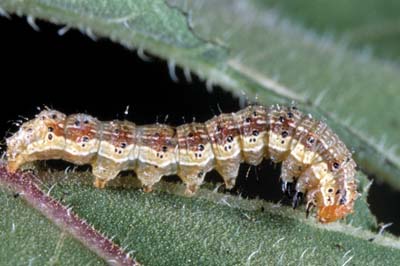
Corn earworm, Heliothis zea, mature larva, feeding on
foliage. This brown form is characteristic of this
insect, though other colors occur.
(Photographer: L. Buss, University of Florida)
The corn earworm insect is a serious pest in sweet corn production but attacks a wide range of crops. As a result, it is also known as the tomato fruitworm, sorghum headworm, vetchworm, and cotton bollworm. Corn and sorghum are the most favorable hosts but most vegetable crops are in the host range. Natural enemies exist but do not provide adequate control of the corn earworm. Cultural control practices include planting trap crops and using resistant host plants. Some varieties of corn are available that have the Bacillus thuringiensis toxin as a source of resistance. Chemical control is also used but resistance has been found to many pesticides.
Images
To save the Web-optimized images shown below to your hard drive:
|
Click to access Display and Print quality images. |
|
Click to access Display and Print quality images. |
|
Click to access Display and Print quality images. |
|
Click to access Display and Print quality images. |